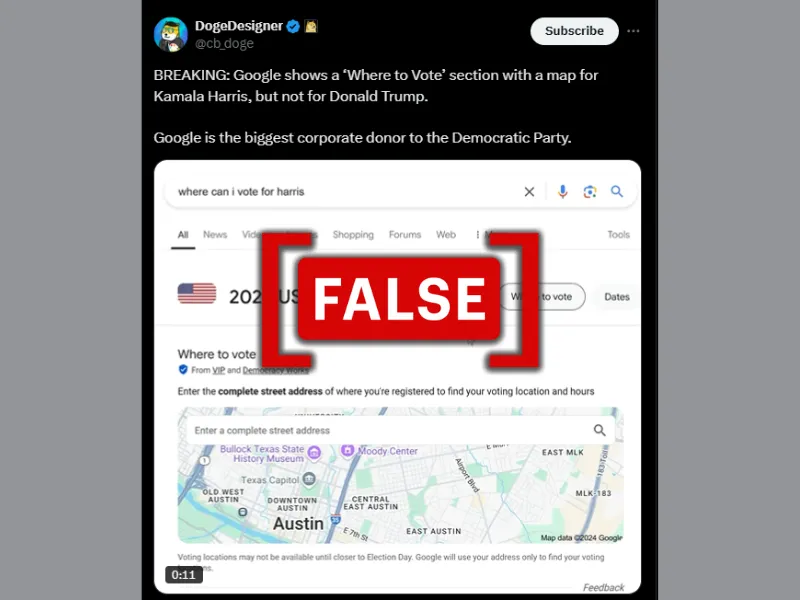By: Karin Koronen
November 7 2024
 Source: X/ Screenshot/ Modified by Logically Facts
Source: X/ Screenshot/ Modified by Logically Facts
Google’s display of a "Where to Vote" section for Kamala Harris but not for Donald Trump was due to a search engine error, not political bias.
Context
On the day of the elections, @dogedesigner, who has expressed avid support for Trump on X, shared a video (archived here) of a Google search with the caption, "BREAKING: Google shows a 'Where to Vote' section with a map for Kamala Harris but not for Donald Trump." The user further claimed that "Google is the biggest corporate donor to the Democratic Party."
The post quickly went viral, amassing over 52.3 million views within a day, and was reshared by thousands of people, including prominent supporters of the MAGA movement, such as Elon Musk (archived here). Many users speculated that Google intentionally favored Democratic candidates, aligning with broader allegations of tech companies showing partisan bias.
However, the discrepancy in results was due to an error by the Google search engine. It was not evidence of Google's bias toward the Democratic Party.
In Fact
Google clarified that this discrepancy stemmed from a technical issue regarding geographic names in search queries. Specifically, the search for "Where to vote Harris" pulled up a voting map for Harris County, Texas, because "Harris" was interpreted as a location rather than the vice president's last name. On the other hand, no city, county, or state is named "Trump," so a similar search for the former president did not yield a map result.
Google explained that similar searches for other names, such as "Where to vote Vance," also produced map-based voting information due to the existence of Vance County. This indicates that the issue was not an intentional act to support one party or candidate but a coincidence based on location-based search terms. Google resolved the problem within four hours of the initial post.
Additionally, Google noted that very few users search for voting information in this manner, and they provided data suggesting that queries of this type saw limited traction.
 Google shared data to showcase the lack of searches for the queries "Where to vote for Harris" and "Where to vote for Trump."
Google shared data to showcase the lack of searches for the queries "Where to vote for Harris" and "Where to vote for Trump."
(Source: X/@newsfromgoogle/Screenshot)
Regarding the claim that "Google is the biggest corporate donor to the Democratic Party," organizations themselves cannot contribute to candidates and party committees, according to federal election law. However, individuals associated with an organization and affiliates of an organization can donate.
According to Opensecrets.org, a repository of U.S. political donation data, employees and affiliates of Google's parent company, Alphabet Inc., contributed around $16 million to political parties in 2024. Of this figure, $14,849,785 went to Democrats.
Therefore, according to data listed by Open Secrets, Alphabet Inc. is not the largest corporate donor to the Democrats but places twenty-second on this list.
The Verdict
The claim that Google intentionally showed voting information for Kamala Harris but not Donald Trump to influence the election is false. This issue arose due to an automated location-based search feature, not deliberate bias.